Tips for Preventing Poison Oak Dermatitis
It's springtime and the flowers are blooming and the poison oak is beginning to leaf out in a beautiful bright green. Outdoor activities such as running, hiking, gardening, and camping may involve inadvertent contact with certain plants that can cause extremely itchy, red rashes. I would like to focus on a group of plants collectively known as Toxicodendron. Plants included in this group are poison oak, poison ivy, and poison sumac (also known as poison dogwood). These plants are notoriously known for containing an antigen in their sap called an oleoresin, or more specifically, urushiol. This oleoresin has a high affinity for binding to proteins in the skin and causes an allergic contact dermatitis. The Toxicodendron group of plants is the most common cause of allergic contact dermatitis in the United States. This article will discuss only Western poison oak (Toxicodendron diversiloba) which is endemic to the West coast, and is commonly found growing in our local parks as well as in many backyards in Portola Valley and Woodside.
Poison oak dermatitis can be acquired from urushiol contaminated fur on pets, clothing, tools, golf clubs, fishing rods, baseball bats, shoes, backpacks, firewood, handling contaminated soil, etc. Furniture can also become contaminated if pets have urushiol on their fur and climb or sit on furniture. Contaminated objects can cause an allergic dermatitis for many years. Dead poison oak still contains active urushiol. There are documented cases of 100 year old specimens of poison oak causing allergic contact dermatitis.
What Does the Rash Look Like and What are the Symptoms?
After the first exposure to poison oak, it may take 7-10 days for the skin rash to appear. Once you have been sensitized to the plant, subsequent exposures result in a rash appearing within 2 days and in some cases within hours. In some cases, it may take 2 weeks after the initial contact before the rash appears. The initial symptoms are itching and redness, this progress to red bumps and red streaks followed by blisters that are often in lines. The blisters will eventually pop and ooze and the skin will become crusty and weepy. The fluid from the blisters does not contain poison oak antigen and will not spread the rash. The itching can reach an unbearable level. Affected skin may become infected with bacteria and impetigo can develop as a secondary complication.
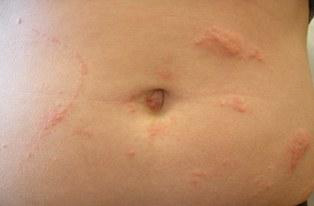
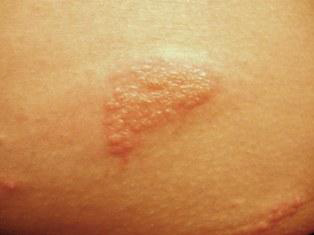
Different areas of the body have different rates of absorption of the urushiol because of differences in skin thickness. The face is involved earlier whereas arms and legs may take several days before the rash appears.
Prevention & Recognition
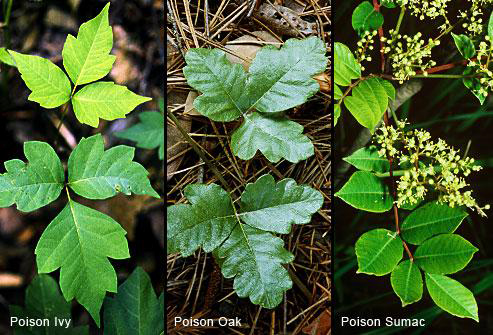
The best strategy is to avoid the urushiol resin that is present in the leaves, stems, seeds, flowers, berries, and roots of poison oak. All parts of the poison oak plant can cause an allergic reaction: the leaves, stems, roots, and vine. You should learn to recognize plants in the Toxicodendron group. "Leaves three, let them be," is the popular warning. However, western poison oak can have 5 or more leaflets. The rounded leaves are glossy and have a scalloped edge. The stem holding the leaflets is grooved and enlarged where it is attached to the branch. There are tiny "holes" in the bark giving the surface a porous looking texture. In the fall, the leaves turn a beautiful scarlet color.
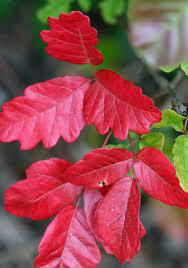
Outdoor areas should be carefully inspected before being chosen as a camping, picnic or impromptu restroom site. Make yourself knowledgeable about plants before gathering them in the forest for a floral arrangement for your home. I had a patient who made her bridal bouquet out of poison oak for her garden wedding!
Treatment
Poison oak protein enters the skin rapidly. You must wash it off within 10 minutes to prevent an allergic contact dermatitis reaction. In general, this is not feasible as when the exposure occurs most of us are far away from home. You should thoroughly wash your entire body with soap and water as soon as possible to remove any oleoresin remaining on the skin. Washing with water alone is not effective because urushiol is water insoluble. (However, water is better than doing nothing if that is your only option!). After the dermatitis appears, washing will not help remove plant oils. However, washing may remove unbound urushiol from dry areas of unaffected appearing skin. The plant sap may remain under one's fingernails unless removed by thorough cleansing with a nail brush. If the poison oak antigen is left under your fingernails, you can spread the plant protein by touching and/or scratching other areas of skin.
Wash contaminated clothing and objects with soap and/ or detergent to remove the oleoresin. Heavily contaminated clothing should be dry cleaned. The severity of the skin dermatitis depends on a number of variables: the amount of urushiol on the skin, location of the dermatitis (face and genitals have a tendency to be more inflamed and uncomfortable), and one's individual susceptibility to the plant antigen. Mild contact dermatitis may respond to Aveeno oatmeal baths or baking soda baths. Itching may be treated with over the counter antihistamines and 1% hydrocortisone cream. This type of contact dermatitis can last weeks without treatment. Seek Dr. Wong's help if you are not improving with the above suggestions. Severe poison oak dermatitis requires prescription medication such as oral cortisone and antihistamines.
Foods that Cross-react with Poison Oak
There is a cross hypersensitivity reaction between poison oak and the oils in the cashew nut plant and the mango plant. The husk and shells of raw cashews contain an oleoresin. Raw cashew nuts may be contaminated with the oil and cause a contact allergic reaction in susceptible individuals. Roasting cashew nuts inactivates the oil protein. Sap from the mango tree and the fruit peel can cause a contact allergic reaction. The fruit itself is not a culprit.
Precautions
There are several products that can be beneficial in minimizing toxicodendron dermatitis if you are anticipating a poison oak exposure: Stokogard, Hollister Moisture Barrier, Ivy block, and Hydropel. These products are barrier creams that block the poison oak antigen from binding to the skin. They are intended to be applied to skin prior to exposure to poison oak. They provide several hours of protection but you still need to wash your skin thoroughly after exposure to poison oak. Stokogard contains amino groups that bind the poison oak antigen to the surface preventing absorption. Ivy Block is an organo-clay mixture that binds urushiol. Ivy Shield is another barrier product that can be used, but it is not as effective as Stokogard or Ivy Block.
Rubber gloves do not protect against poison oak. The urushiol is soluble in rubber. If you must touch toxicodendron plants wear heavy duty vinyl gloves. Dispose of the gloves after use or wash them well in soap and water.
Testing a Plant for Urushiol
I do not recommend doing this but if you are not certain if a plant is part of the Toxicodendron family, you can perform the following test.
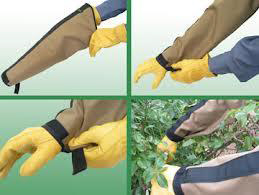
It is extremely important to wear protective clothing and heavy-duty vinyl gloves when doing this.
Take parts of the plant in question and crush the leaves and stems on white paper so a wet spot appears. The test will not work if there is not enough sap released to wet the paper. Make sure there are plenty of layers of newspapers underneath the white paper so the plant fluids do not leak through. The clear sap should turn into a brown spot after 10-15 minutes, then black within 24 hours. Carefully dispose of the paper by wrapping it well in the newspaper before discarding it in the trash. Do not place it in the recycling yard waste container.
Removing Poison Oak, Poison Ivy, Poison Sumac From the Garden
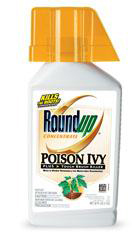
Roundup Poison Ivy PlusTough Brush Killer is an effective method to eliminate toxicodendron plants from your property. It contains glyphosphate and triclopyr amine. You should see Dr. Wong if you are developing signs poison oak dermatitis. The rash is extremely itchy and can last for many weeks. Secondary bacterial infections and scarring can be a complication from scratching. If you have atopic dermatitis or eczema, these skin conditions can flare.